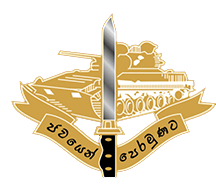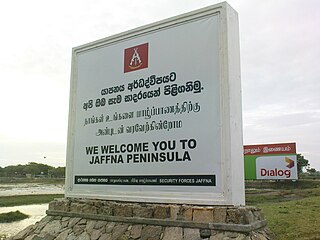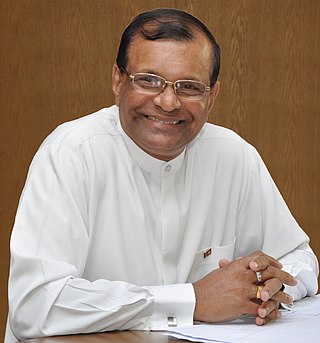Related Research Articles

Kilinochchi is the main town of Kilinochchi District, Northern Province of Sri Lanka. Kilinochchi is situated at the A9 road some 100 km (62 mi) south-east of Jaffna. It was the administrative center and de facto capital of the LTTE until 2 January 2009, when troops of the Sri Lankan Army recaptured the city.

Indian Peace Keeping Force (IPKF) was the Indian military contingent performing a peacekeeping operation in Sri Lanka between 1987 and 1990. It was formed under the mandate of the 1987 Indo-Sri Lankan Accord that aimed to end the Sri Lankan Civil War between Sri Lankan Tamil militant groups such as the Liberation Tigers of Tamil Eelam (LTTE) and the Sri Lankan military.

The Sri Lanka Army is the oldest and largest of the Sri Lanka Armed Forces. The army was officially established as the Ceylon Army in 1949, though the army traces its roots back in 1881 when Ceylon Light Infantry Volunteers was created; the army was renamed as the 'Sri Lanka Army' when Sri Lanka became a republic in 1972. In 2024, the Army had approximately 150,000 personnel.
Operation Pawan was the code name assigned to the operation by the Indian Peace Keeping Force (IPKF) to take control of Jaffna from the Liberation Tigers of Tamil Eelam (LTTE), better known as the Tamil Tigers, in late 1987 to enforce the disarmament of the LTTE as a part of the Indo-Sri Lanka Accord. In brutal fighting lasting about three weeks, the IPKF took control of the Jaffna Peninsula from the LTTE, something that the Sri Lankan Army had tried but failed to do. Supported by Indian Army tanks, helicopter gunships and heavy artillery, the IPKF routed the LTTE at the cost of 214 soldiers and officers.

Jaffna District is one of the 25 districts of Sri Lanka, the second level administrative division of the country. The district is administered by a District Secretariat headed by a District Secretary appointed by the central government of Sri Lanka. The capital of the district is the city of Jaffna.

The Sri Lanka Armoured Corps (SLAC) provides the armour capability of the Sri Lanka Army, with vehicles such as the T-55AM2, and type 80/88 main battle tanks; the BMP infantry fighting vehicle; and the BTR-80, and WZ551 armoured personnel carriers. It comprises five regular armoured regiments, a volunteer regiment, and a regimental band. It has an independent Armoured Brigade and is headquartered at Rock House Army Camp, Colombo.
The Second Battle of Elephant Pass, was fought in April 2000 for the control of the Sri Lankan military base in Elephant Pass, Jaffna.
The Battle of Jaffna was fought in two phases in August and October 2006 for the Jaffna peninsula. It was the fourth battle for the peninsula since the start of the Sri Lankan civil war.
Operation Riviresa, was a combined military operation launched by the Sri Lankan Armed Forces in Jaffna. Starting on 17 October 1995, the primary objective of the operation was the capture of the city of Jaffna and rest of the Jaffna peninsula from the LTTE. It is believed that Operation Riviresa was the largest and most successful military operation in Sri Lankan Armed Forces during the Third Eelam War.

Major General Janaka Perera, RWP, RSP, VSV, USP, VSP was a Sri Lankan General and politician. He served as the Chief of Staff of the Sri Lanka Army and is considered one of the most distinguished generals in Sri Lankan history. After retiring from the army he served as a Sri Lankan High Commissioner to Australia and Ambassador to Indonesia. He was the opposition leader of the North Central Provincial Council until he and his wife were killed on 6 October 2008 by a suicide bomber. The LTTE have been blamed for the bombing by Sri Lankan president Mahinda Rajapaksa.

The Mechanized Infantry Regiment (MIR) is a mechanized infantry regiment of the Sri Lanka Army. It is made up of four regular battalions and a volunteer battalion. Establish in 2007 by Lt. Gen. Sarath Fonseka its battalions are equipped with Type 63 and WZ551 armoured personnel carriers make up the Mechanized Infantry Brigade. It is the youngest Infantry regiment of the Army.

The 1978 Constitution of Sri Lanka provides for the election of members of Parliament from 22 multi-member electoral districts through the proportional representation electoral system.

Security Forces Headquarters – Jaffna (SFHQ-J) is a regional command of the Sri Lanka Army, that is responsible for the operational deployment and command all army units stationed in and around the Jaffna Peninsula in the Northern Province.
The 58 Division is a division of the Sri Lanka Army formed in 2008, prior to which it was known as Task Force 1 from 2007 to 2009. A principal offensive division, it is currently deployed for combat operations in the Wanni region. The Special Forces Brigade has been attached to the division.
The 53 Division is an elite combined infantry division of the Sri Lanka Army. Trained and formed in 1996 under the leadership of US military officers, the unit was used as a principal offensive division during the War, having been deployed for combat operations in the Jaffna Peninsula, and was under the command of Security Forces Headquarters - Jaffna. The brigades of the 53 Division are also trained by the US Special Forces, which have been closely involved with its development and training since 1997. The 53 division consists of the Airmobile Brigade, a Mechanised Infantry Brigade and a Special Forces Brigade. At present, it is headquartered at Inamaluwa, Dambulla and serves as one of two infantry divisions in the Reserve Strike Force (RSF) under the direct command of the I Corps capable of acting as a rapid reaction force (RRF).

Major General Gammanpila Arachchige Chandrasiri, RWP, USP, ndc, psc, SLAC was a Sri Lankan senior army officer and a provincial governor. He is the Governor of Northern Province. He was the former Commander Security Forces Headquarters - Jaffna ; General Officer Commanding, 52 Division;, Director General - General Staff, Joint Operations Headquarters; Brigade Commander Armoured Brigade, and Commander, Area Headquarters Mannar.
Divisions of the Liberation Tigers of Tamil Eelam refers to the military, intelligence and overseas divisions the Liberation Tigers of Tamil Eelam (LTTE). Most of these divisions were destroyed during the Eelam War IV, and only parts of the intelligence and financing divisions remain overseas.
Major General Jeewaka Ruwan Kulatunga, RSP, ndc, psc, is a retired Sri Lankan general. He served as the Chief of National Intelligence having served as the Commandant of the Defence Services Command and Staff College and the Deputy Vice Chancellor of the General Sir John Kotelawala Defence University.
References
- ↑ "Archived copy". Archived from the original on 2009-02-20. Retrieved 2009-02-18.
{{cite web}}: CS1 maint: archived copy as title (link)